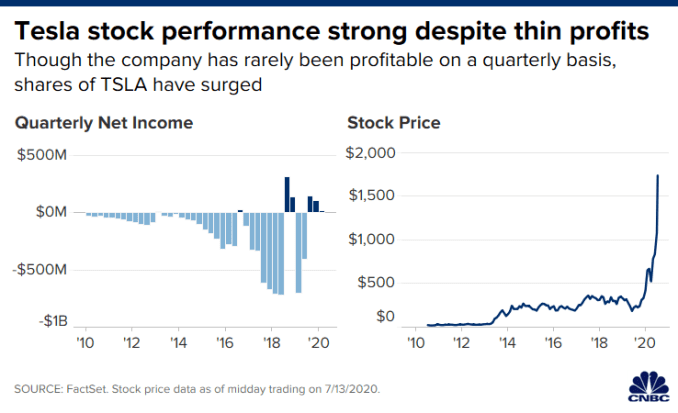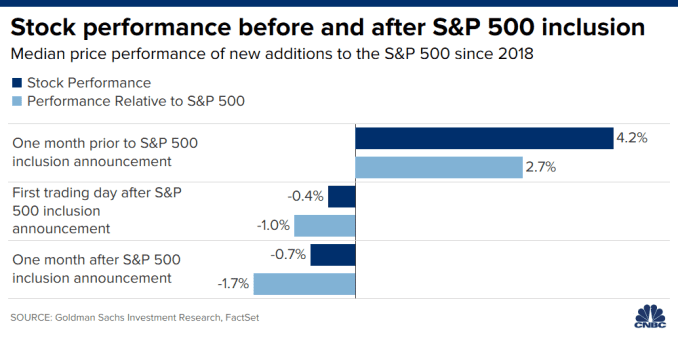
Tesla plans to report its second quarter results on Wednesday after the market closes, and all eyes are on the company’s bottom line this period.
That’s because a fourth consecutive quarter of reported profitability on a GAAP basis would make Elon Musk’s electric car company eligible to join the S&P 500 index.
Speculation has mounted that the company will hit this milestone — a full year of reported profitability — since Tesla reported a record number of car deliveries earlier in July. Elon Musk fueled the rumors, sending an email to employees implying that there’s a chance the company will break even for the quarter.
Shares have jumped more than 50% this month alone — adding to the stock’s more than threefold increase this year — as investors have bet on the company’s inclusion, which could mean a sudden jump in demand from passive funds that track the benchmark.
But it’s not a done deal. Even if the company does report a fourth consecutive quarter of GAAP profits, there’s no guarantee that it will be added to the S&P 500.
What it takes to join the S&P 500
The make-up of the S&P 500 is determined by what’s known as the “Index Committee” at S&P Dow Jones Indices. Inclusion in the index is based on quantitative as well as qualitative factors.
Companies must be U.S. based, and listed on either the NYSE, the Nasdaq or the Cboe. They also must have a market cap of more than $8.2 billion, and report four straight quarters of profit as determined by U.S. generally accepted accounting principles (GAAP).
Even if a company meets these criteria as well as the other stipulations, however, it still does not guarantee inclusion in the index, according to Howard Silverblatt, senior index analyst at S&P Dow Jones Indices.
“The purpose of the index is to emulate the U.S. domestic common market,” he said. “When you go to put a company in — to actually select it — it’s got to fit into the algorithm in that it represents the market, it has liquidity, it has size,” he added.
The committee meets on a quarterly basis to rebalance the index, and the next meeting is scheduled for the third Friday in September. But Silverblatt said companies can be added or removed from the S&P at any time.
Given the potentially market-moving nature of additions and deletions from the index, the process is tightly guarded. Even companies that are set to be added receive no advance warning.
Silverblatt said that a notice typically goes out at 5:15 pm ET five trading days before a company is set to join the index.
There are particular challenges to adding a company of Tesla’s size to the index, since every other component’s weighting would subsequently have to be adjusted. Additionally, it would force index investors to sell portions of their other 499 stock holdings to make room for the company.
With a market capitalization of $304 billion, according to FactSet, Tesla is the 12th largest U.S. company, ahead of names like JPMorgan, UnitedHealth and Home Depot. Research firm Baird noted that it would be the largest company ever added to the index.
According to analysis from Credit Suisse, Facebook was the last mega cap company added to the index back in 2013, when it was worth roughly $120 billion.
“Accordingly, it’s possible an S&P add may not occur until 2021,” the firm said, noting the company’s size. “That said, once Tesla becomes eligible, we would expect S&P to see pressure to add Tesla to the index.”
Speculation began building that Tesla could turn a profit in the second quarter after vehicle deliveries beat Street expectations. The company delivered 90,650 vehicles in the second quarter — the closest approximation of sales numbers reported by Tesla — topping the 72,000 number expected by analysts surveyed by FactSet.
Elon Musk himself added to the speculation when he sent an email to employees, which was promptly leaked to the press, urging everyone to “go all out” ahead of the delivery figures’ release.
In the email, he also said that “breaking even is looking super tight.” It wasn’t immediately clear whether he was referring to the company’s profit margin or another metric, such as production numbers, but some took it to mean that a second quarter profit was indeed possible.
Despite investor enthusiasm for the stock, which has seen shares nearly quadruple this year, the Street is more tempered ahead of the company’s quarterly report. According to estimates compiled by Refinitiv, analysts are expecting the company to report a loss of 11 cents per share, on revenue of $5.233 billion.
“We are cautious into the quarter given recent share appreciation; there is a chance TSLA does not achieve GAAP profitability, which we think would be a significant negative catalyst given current elevated expectations,” Baird analyst Ben Kallo wrote in a recent note to clients. He said that investors should take profits ahead of earnings, while also noting that the company “will likely be added to the S&P 500 index.”

Index inclusion already priced in?
It’s hard to overstate the recent rally in Tesla shares. Through Monday’s close the stock is up 52% in the last month, 292% year to date, and 536% in the last year. The stock has been a favorite among retail investors. Data from Robintrack, which tracks millennial-favored trading app Robinhood, shows that the stock is among the top holdings on the platform.
But given the recent run-up in shares, some investors believe that the stock price is preemptively reflecting inclusion in the S&P 500, and the subsequent flood of new demand.
According to Larry McDonald, editor of The Bear Traps Report, there’s around $3.9 trillion of pure index capital tracking the S&P 500. As of Monday morning, per his analysis, Tesla had a free float market cap of $220 billion (this number excludes the 18.38% of the company that Musk owns).
Taking the total S&P market value to be $27.8 trillion, this would give Tesla a 0.8% weighting if it were to join the index. This means that funds tracking the index would need to buy roughly $30 billion worth of Tesla stock.
Not to mention active managers that track the index, as well as individual investors who favor portfolios tied to the S&P 500.
With a potential upcoming buying spree, McDonald believes the recent run is driven not by fundamental strength, but by investors bidding up shares.
“By buying up Tesla TSLA now, front-runners are forcing the S&P Indexes to give the stock a higher and higher weighting,” he wrote in a recent note. “Thus, ETFs / Indexes will be forced to pay up, buying even more shares. Then the hot money exits, leaving indexes holding the bag,” he said.

While Tesla’s rally might be extreme, it’s not unusual for stocks to move higher on speculation about inclusion in the index.
Goldman Sachs analyzed performance for additions to the index going back to 2018, and found that a stock typically rallies 4% in the month leading up to its addition to the index. One month later, however, the stock was down an average of 1%, although still beating the broader market.


























